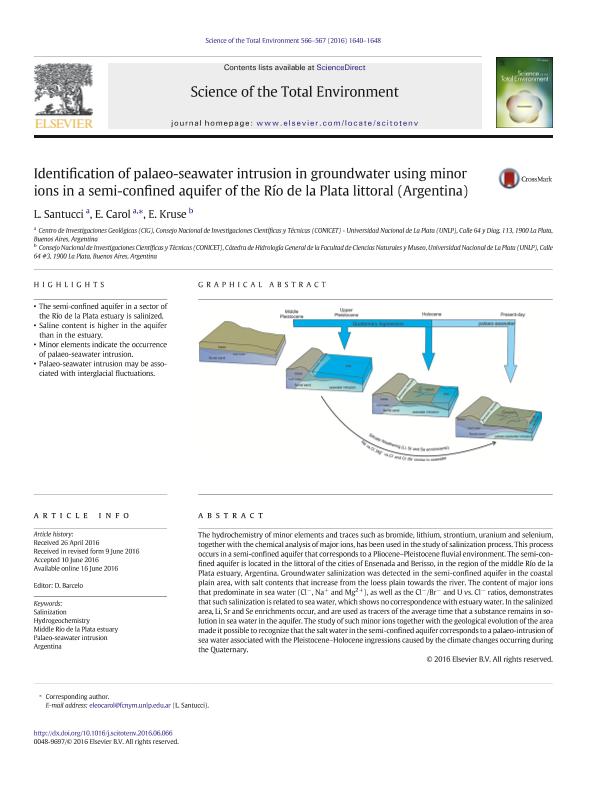Mostrar el registro sencillo del ítem
dc.contributor.author
Santucci, Lucía

dc.contributor.author
Carol, Eleonora Silvina

dc.contributor.author
Kruse, Eduardo Emilio

dc.date.available
2018-06-19T15:38:47Z
dc.date.issued
2016-10
dc.identifier.citation
Santucci, Lucía; Carol, Eleonora Silvina; Kruse, Eduardo Emilio; Identification of palaeo-seawater intrusion in groundwater using minor ions in a semi-confined aquifer of the Río de la Plata littoral (Argentina); Academic Press Inc Elsevier Science; Science of the Total Environment; 566-567; 10-2016; 1640-1648
dc.identifier.issn
0048-9697
dc.identifier.uri
http://hdl.handle.net/11336/49265
dc.description.abstract
The hydrochemistry of minor elements and traces such as bromide, lithium, strontium, uranium and selenium, together with the chemical analysis of major ions, has been used in the study of salinization process. This process occurs in a semi-confined aquifer that corresponds to a Pliocene–Pleistocene fluvial environment. The semi-confined aquifer is located in the littoral of the cities of Ensenada and Berisso, in the region of the middle Río de la Plata estuary, Argentina. Groundwater salinization was detected in the semi-confined aquifer in the coastal plain area, with salt contents that increase from the loess plain towards the river. The content of major ions that predominate in sea water (Cl−, Na+ and Mg2 +), as well as the Cl−/Br− and U vs. Cl− ratios, demonstrates that such salinization is related to sea water, which shows no correspondence with estuary water. In the salinized area, Li, Sr and Se enrichments occur, and are used as tracers of the average time that a substance remains in solution in sea water in the aquifer. The study of such minor ions together with the geological evolution of the area made it possible to recognize that the salt water in the semi-confined aquifer corresponds to a palaeo-intrusion of sea water associated with the Pleistocene–Holocene ingressions caused by the climate changes occurring during the Quaternary.
dc.format
application/pdf
dc.language.iso
eng
dc.publisher
Academic Press Inc Elsevier Science

dc.rights
info:eu-repo/semantics/openAccess
dc.rights.uri
https://creativecommons.org/licenses/by-nc-sa/2.5/ar/
dc.subject
Argentina
dc.subject
Hydrogeochemistry
dc.subject
Middle RÍO de La Plata Estuary
dc.subject
Palaeo-Seawater Intrusion
dc.subject
Salinization
dc.subject.classification
Meteorología y Ciencias Atmosféricas

dc.subject.classification
Ciencias de la Tierra y relacionadas con el Medio Ambiente

dc.subject.classification
CIENCIAS NATURALES Y EXACTAS

dc.title
Identification of palaeo-seawater intrusion in groundwater using minor ions in a semi-confined aquifer of the Río de la Plata littoral (Argentina)
dc.type
info:eu-repo/semantics/article
dc.type
info:ar-repo/semantics/artículo
dc.type
info:eu-repo/semantics/publishedVersion
dc.date.updated
2018-06-18T21:21:06Z
dc.journal.volume
566-567
dc.journal.pagination
1640-1648
dc.journal.pais
Estados Unidos

dc.description.fil
Fil: Santucci, Lucía. Consejo Nacional de Investigaciones Científicas y Técnicas. Centro Científico Tecnológico Conicet - La Plata. Centro de Investigaciones Geológicas. Universidad Nacional de La Plata. Facultad de Ciencias Naturales y Museo. Centro de Investigaciones Geológicas; Argentina
dc.description.fil
Fil: Carol, Eleonora Silvina. Consejo Nacional de Investigaciones Científicas y Técnicas. Centro Científico Tecnológico Conicet - La Plata. Centro de Investigaciones Geológicas. Universidad Nacional de La Plata. Facultad de Ciencias Naturales y Museo. Centro de Investigaciones Geológicas; Argentina
dc.description.fil
Fil: Kruse, Eduardo Emilio. Consejo Nacional de Investigaciones Científicas y Técnicas. Centro Científico Tecnológico Conicet - La Plata; Argentina. Universidad Nacional de La Plata. Facultad de Ciencias Naturales y Museo. Cátedra de Hidrología General; Argentina
dc.journal.title
Science of the Total Environment

dc.relation.alternativeid
info:eu-repo/semantics/altIdentifier/doi/http://dx.doi.org/10.1016/j.scitotenv.2016.06.066
dc.relation.alternativeid
info:eu-repo/semantics/altIdentifier/url/https://www.sciencedirect.com/science/article/pii/S0048969716312396
Archivos asociados
